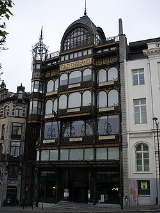
Paul Saintenoy
Encyclopedia
Paul Saintenoy was a Belgian
architect
, teacher, architectural historian, and writer.
Born in Ixelles, in the Brussels-Capital Region, he was the son of an architect. He began studying architecture in Antwerp in 1881 then returned home to complete his training in Brussels
. With an interest in archaeology
, for a time he served as the general secretary of the "Royal Society of Archaeology" in Brussels. In 1910 he embarked upon a teaching career at the Académie Royale des Beaux-Arts
in Brussels.
At the end of World War I
, Saintenoy was appointed a member of the "Royal Commission of Monuments and Sites" where he played an important role in the reconstruction of Belgium following the devastation of the war.
Paul Saintenoy died in 1952 and was interred in the Ixelles Cemetery
, in the southern part of Brussels.
Noted works:
Belgium
Belgium , officially the Kingdom of Belgium, is a federal state in Western Europe. It is a founding member of the European Union and hosts the EU's headquarters, and those of several other major international organisations such as NATO.Belgium is also a member of, or affiliated to, many...
architect
Architect
An architect is a person trained in the planning, design and oversight of the construction of buildings. To practice architecture means to offer or render services in connection with the design and construction of a building, or group of buildings and the space within the site surrounding the...
, teacher, architectural historian, and writer.
Born in Ixelles, in the Brussels-Capital Region, he was the son of an architect. He began studying architecture in Antwerp in 1881 then returned home to complete his training in Brussels
Brussels
Brussels , officially the Brussels Region or Brussels-Capital Region , is the capital of Belgium and the de facto capital of the European Union...
. With an interest in archaeology
Archaeology
Archaeology, or archeology , is the study of human society, primarily through the recovery and analysis of the material culture and environmental data that they have left behind, which includes artifacts, architecture, biofacts and cultural landscapes...
, for a time he served as the general secretary of the "Royal Society of Archaeology" in Brussels. In 1910 he embarked upon a teaching career at the Académie Royale des Beaux-Arts
Académie Royale des Beaux-Arts
The Académie Royale des Beaux-Arts in Brussels is an art school, founded in 1711.The faculty and alumni of ARBA include some of the most famous names in Belgian painting, sculpture, and architecture: James Ensor, Rene Magritte, and Paul Delvaux...
in Brussels.
At the end of World War I
World War I
World War I , which was predominantly called the World War or the Great War from its occurrence until 1939, and the First World War or World War I thereafter, was a major war centred in Europe that began on 28 July 1914 and lasted until 11 November 1918...
, Saintenoy was appointed a member of the "Royal Commission of Monuments and Sites" where he played an important role in the reconstruction of Belgium following the devastation of the war.
Paul Saintenoy died in 1952 and was interred in the Ixelles Cemetery
Ixelles Cemetery
The Ixelles Cemetery , located in Ixelles in the southern part of Brussels, is one of the major cemeteries in Belgium....
, in the southern part of Brussels.
Noted works:
- Old England Department Store, Brussels (1899)
- Hôtel Baron Lunden, Brussels (1898)
- Maison Losseau, MonsMonsMons is a Walloon city and municipality located in the Belgian province of Hainaut, of which it is the capital. The Mons municipality includes the old communes of Cuesmes, Flénu, Ghlin, Hyon, Nimy, Obourg, Baudour , Jemappes, Ciply, Harmignies, Harveng, Havré, Maisières, Mesvin, Nouvelles,...
(1899)

